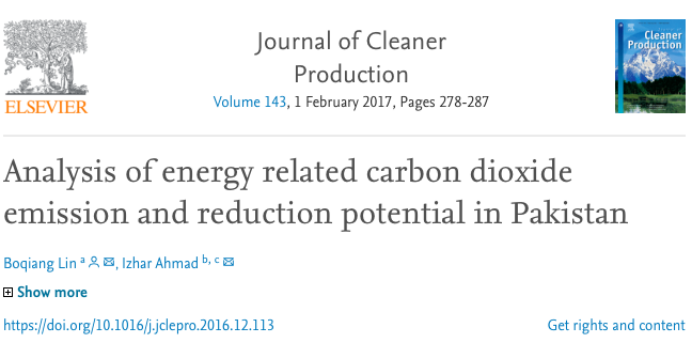
题目:巴基斯坦能源相关二氧化碳排放和减排潜力分析(Analysis of energy related carbon dioxide emission and reduction potential in Pakistan)
作者:林伯强*,Izhar Ahmad
期刊:清洁生产 (Journal of Cleaner Production)
详细:第143卷,2017年2月1日,第278-287页
DOI:https://doi.org/10.1016/j.jclepro.2016.12.113
文献导读:
气候变化是指温室气体(GHG),特别是二氧化碳(CO2)在大气中的浓度增加而导致的全球变暖。2010年,全球温室气体排放的68%归因于能源部门,包括90%的二氧化碳、9%的甲烷和1%的一氧化二氮和其他气体排放。气候变化会影响生态系统的功能和结构,并对物种及其栖息地产生负面影响,同时也会对水资源供应、粮食安全和人类健康产生不利影响。为了减轻气候变化的影响,全球社会正在努力将全球平均温度到本世纪末的上升限制在2°C。
巴基斯坦是最容易受气候变化影响的国家之一。2010年以来,巴基斯坦经历了史无前例的极端气候事件,造成60亿美元的经济损失。尽管巴基斯坦对全球碳排放的贡献不到百分之一(0.8%),巴基斯坦政府仍致力于通过减少温室气体排放来应对气候变化。能源、交通、农牧业、林业,城镇规划和工业部门是需要加以干预以减轻其对气候变化影响的关键领域。
但是,由于工业化和经济扩张,政府采取建立火力发电厂以增加电力供应。这项政策对国际收支、能源安全和环境可持续能力产生重要影响。巴基斯坦愿景(2014)已获得批准,目标是缓解经济增长与气候变化的关系,减少能源贫困。本文主要研究以下几个问题:(1)影响二氧化碳排放变化的主要因素是什么?(2)每个驱动因素的影响程度如何?(3)未来的二氧化碳排放量是多少?减排潜力有多大?(4) 减少二氧化碳排放的政策含义是什么?回答上述问题不仅可以为巴基斯坦的能源政策制定提供参考,对其它寻求经济增长加速转型的经济体也将有所帮助。
Abstract:
Climate change is one of the most dangerous and complex issues human being has ever encountered. Pakistan is one of the highly vulnerable countries to the effects of climate change. CO2 emission from the combustions of fossil fuels is usually considered as the major factor of climate change. This study attempted to analyze the energy related CO2 emissions in Pakistan for a sample period of 1990-2014.The LMDI (Logarithmic Mean Divisia Index) method is applied to extended Kaya identity to decompose the change in emissions into pre-determined factors. According to our analysis, the increase in GDP per capita and populations are the major factors responsible for the increase in energy related CO2 emissions. Carbon intensity contributes to the reduction of emissions. Energy intensity and fuel substitution has mixed and unstable effect on the reduction of emission. The decomposed effects are also used in predicting future CO2 emission for the period 2015-2025. Based on the predicted results, the reduction potential of CO2 emissions in Pakistan is estimated, using special designed scenario analysis. The findings show that emissions will reach 251.5 Mt CO2 in 2025 as per BAU (Business as usual) scenario. The reduction potential for the year 2025 is estimated as 28.94 Mt CO2 and 55.02 Mt CO2 as per moderate and aggressive emission reduction scenario, respectively. The findings show that carbon tax, energy price reforms, diversification of energy supply in favor of cleaner energy and energy conservation are critical to materialize the emission reduction potential.
Keywords: CO2 emissions; LMDI method; Emissions reduction potential; Pakistan
 厦大总机:0592-2180000
|
地址:福建省厦门市思明区思明南路422号
|
邮政编码:361005
厦大总机:0592-2180000
|
地址:福建省厦门市思明区思明南路422号
|
邮政编码:361005